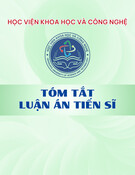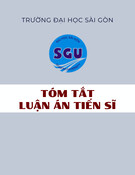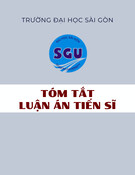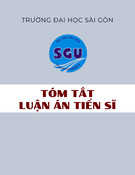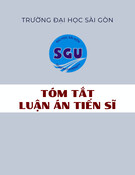
Annals of Mathematics
Global hyperbolicity of
renormalization
for Cr unimodal mappings
By Edson de Faria, Welington de Melo and
Alberto Pinto*

Annals of Mathematics,164 (2006), 731–824
Global hyperbolicity of renormalization
for Crunimodal mappings
By Edson de Faria∗, Welington de Melo∗∗ and Alberto Pinto∗∗*
Abstract
In this paper we extend M. Lyubich’s recent results on the global hyper-
bolicity of renormalization of quadratic-like germs to the space of Crunimodal
maps with quadratic critical point. We show that in this space the bounded-
type limit sets of the renormalization operator have an invariant hyperbolic
structure provided r≥2+αwith αclose to one. As an intermediate step be-
tween Lyubich’s results and ours, we prove that the renormalization operator
is hyperbolic in a Banach space of real analytic maps. We construct the lo-
cal stable manifolds and prove that they form a continuous lamination whose
leaves are C1codimension one, Banach submanifolds of the ambient space,
and whose holonomy is C1+βfor some β>0. We also prove that the global
stable sets are C1immersed (codimension one) submanifolds as well, provided
r≥3+αwith αclose to one. As a corollary, we deduce that in generic, one-
parameter families of Crunimodal maps, the set of parameters corresponding
to infinitely renormalizable maps of bounded combinatorial type is a Cantor
set with Hausdorff dimension less than one.1
Table of Contents
1. Introduction
2. Preliminaries and statements of results
2.1. Quadratic unimodal maps
2.1.1. The Banach spaces Ar
2.1.2. The Banach spaces Br
2.2. The renormalization operator
2.3. The limit sets of renormalization
*Financially supported by CNPq Grant 301970/2003-3.
∗∗ Financially supported by CNPq Grant 304912/2003-4 and Faperj Grant E-26/152.189/
2002.
∗∗∗Financially supported by Calouste Gulbenkian Foundation, PRODYN-ESF, POCTI
and POSI by FCT and Minist´erio da CTES, and CMUP.
1There is a list of symbols used in this paper, before the references, for the convenience
of the reader.

732 EDSON DE FARIA, WELINGTON DE MELO, AND ALBERTO PINTO
2.4. Hyperbolic basic sets
2.5. Hyperbolicity of renormalization
3. Hyperbolicity in a Banach space of real analytic maps
3.1. Real analyticity of the renormalization operator
3.2. Real analytic hybrid conjugacy classes
3.3. Hyperbolic skew-products
3.4. Skew-product renormalization operator
3.5. Hyperbolicity of the renormalization operator
4. Extending invariant splittings
4.1. Compatibility
5. Extending the invariant splitting for renormalization
5.1. H¨older norms and L-operators
5.2. Bounded geometry
5.3. Spectral estimates
6. The local stable manifold theorem
6.1. Robust operators
6.2. Stable manifolds for robust operators
6.3. Uniform bounds
6.4. Contraction towards the unstable manifolds
6.5. Local stable sets
6.6. Tangent spaces
6.7. The main estimates
6.8. The local stable sets are graphs
6.9. Proof of the local stable manifold theorem
7. Smooth holonomies
7.1. Small holonomies for robust operators
8. The renormalization operator is robust
8.1. A closer look at composition
8.2. Checking properties B2 and B3
8.3. Checking property B4
8.4. Checking properties B5 and B6
8.5. Proof of Theorem 8.1
8.6. Proof of the hyperbolic picture
8.6.1. Proof of Theorem 2.5
8.6.2. Proof of Corollary 2.6
9. Global stable manifolds and one-parameter families
9.1. The global stable manifolds of renormalization
9.2. One-parameter families
10. A short list of symbols
References

GLOBAL HYPERBOLICITY OF RENORMALIZATION 733
1. Introduction
In 1978, M. Feigenbaum [10] and independently P. Coullet and C. Tresser
[4] made a startling discovery concerning certain rigidity properties in one-
dimensional dynamics. While analysing the transition between simple and
“chaotic” dynamical behavior in “typical” one-parameter families of unimodal
maps – such as the quadratic family x→ λx(1 −x) – they recorded the
parameter values λnat which successive period-doubling bifurcations occurred
in the family and found a remarkable universal scaling law, namely
λn−λn−1
λn+1 −λn
→4.669 ... .
They also found universal scalings within the geometry of the post-critical set
of the limiting map corresponding to the parameter λ∞= lim λn(cf. the work
of E. Vul, Ya. Sinai and K. Khanin [29]). In an attempt to explain these
phenomena, they introduced a certain nonlinear operator acting on the space
of unimodal maps – the so-called period doubling operator. They conjectured
that the period-doubling operator has a unique fixed point which is hyperbolic
with a one-dimensional unstable direction. They also conjectured that the
universal constants they found in their experiments are the eigenvalues of the
derivative of the operator at the fixed point.
A few years later (1982) this conjecture was confirmed by O. Lanford
[18] through a computer assisted proof. Working in a cleverly defined Banach
space of real analytic maps and using rigorous numerical analysis on the com-
puter, Lanford established at once the existence and hyperbolicity of the fixed
point of the period-doubling operator. Subsequent work by M. Campanino and
H. Epstein [2] (also Campanino et al. [3] and Epstein [9]) established the ex-
istence (but neither uniqueness nor hyperbolicity) of the fixed point without
essential help from the computer.
It was soon realized by Lanford and others that the period-doubling op-
erator was just a restriction of another operator acting on the space of uni-
modal maps – the renormalization operator – whose dynamical behavior is
much richer. The hopes were high that the iterates of this operator would
reveal the small scale geometric properties of the critical orbits of many inter-
esting one-dimensional systems. Hence, the initial conjecture was generalized
to the following.
Renormalization Conjecture.The limit set of the renormalization
operator in the space of maps of bounded combinatorial type is a hyperbolic
Cantor set where the operator acts as the full shift in a finite number of symbols.
(For a precise formulation of what is meant by bounded combinatorial
type, see §2.2 below.)

734 EDSON DE FARIA, WELINGTON DE MELO, AND ALBERTO PINTO
In the path towards a proof of this conjecture, several new ideas were
developed in the last 20 years by a number of mathematicians, especially
D. Sullivan, C. McMullen and M. Lyubich. Among the deepest in Dynam-
ical Systems, these ideas have the complex dynamics of quadratic-like maps
(in the sense of Douady and Hubbard [6]) as a common thread. Sullivan proved
in [28] that all limits of renormalization are quadratic-like maps with a definite
modulus. Then, constructing certain Teichm¨uller spaces from quadratic-like
maps and using a substitute of Schwarz’s lemma in these spaces, Sullivan es-
tablished the existence of horseshoe-like limit sets for renormalization. Later,
using a different approach based on Mostow rigidity, McMullen [23] gave an-
other proof of this result and went further by showing that the convergence
(in the C0sense) towards the limit set is exponential.
The final breakthrough came with the work of Lyubich [20]. He endowed
the space of germs of quadratic-like maps (modulo affine conjugacies) with a
very subtle complex structure, showing that the renormalization operator is
complex-analytic with respect to such a structure. In Lyubich’s space, the
stable sets of maps in the limit set of renormalization coincide with the very
hybrid classes of such maps, and inherit a natural structure making them (com-
plex codimension one) analytic submanifolds. Combining McMullen’s rigidity
of towers with Schwarz’s lemma in Banach spaces, Lyubich proved exponential
contraction along such stable leaves. To obtain expansion in the transversal
directions to such leaves at points of the limit set, Lyubich argued by contra-
diction: if expansion fails, then one can find a map in the limit set whose orbit
under renormalization is slowly shadowed by another orbit (the small orbits
theorem, page 323 of [20]). This however contradicts another theorem of his,
namely the combinatorial rigidity theorem of [21]. It follows that the limit set
is indeed hyperbolic in the space of germs. Based on this result of Lyubich and
using the real and complex bounds given by Sullivan, we prove in Theorem 2.4
that the attractor (for bounded combinatorics) is hyperbolic in a Banach space
of real analytic maps.
In the present paper, we give the last step in the proof of the above renor-
malization conjecture in the (much larger) space of Crsmooth unimodal maps
with rsufficiently large. The very formulation of the conjecture in this setting
requires some care, because the renormalization operator is not differentiable
in Cr. For the correct formulation, see Theorem 2.5 below. To prove the
conjecture, we combine Theorem 2.4 with some nonlinear functional analysis
inspired by the work of A. Davie [5]. In that work, Davie constructs the stable
manifold of the fixed point of the period doubling operator in the space of
C2+εmaps “by hand”, showing it to be a C1codimension-one submanifold of
the ambient space, even though the operator is not differentiable. To do this,
he first extends the hyperbolic splitting of the derivative at the fixed point
from Lanford’s Banach space of real-analytic maps to the larger space of C2+ε


